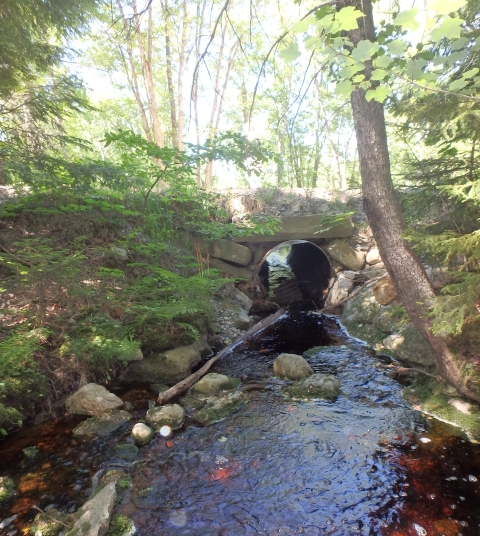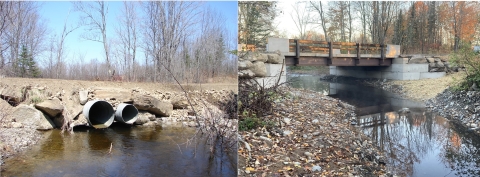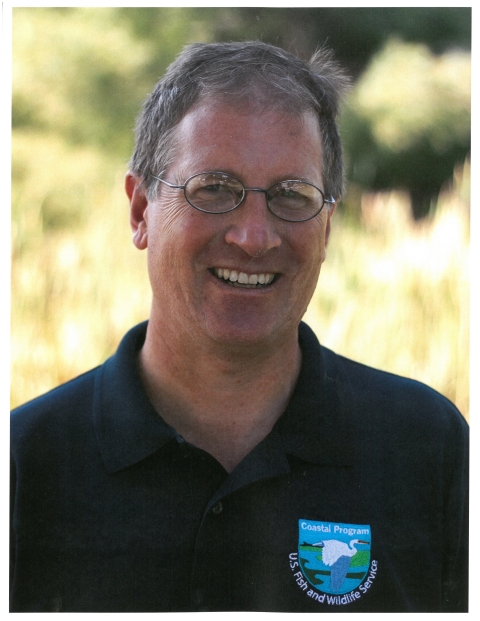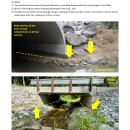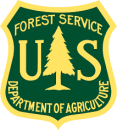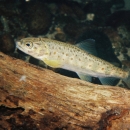Stream Crossing Programmatic Section 7 Section 7
Section 7 Consultation
The Endangered Species Act (ESA) directs all Federal agencies to work to conserve endangered and threatened species and to use their authorities to further the purposes of the Act. Section 7 of the Act, called "Interagency Cooperation," is the mechanism by which Federal agencies ensure the actions they take, including those they fund or authorize, do not jeopardize the existence of any listed species.
Learn more about Section 7 Consultation
Fish passage is the ability of fish or other aquatic species to move freely throughout their life to find food, reproduce, and complete their natural migration cycles. Millions of barriers to fish passage across the country are fragmenting habitat and leading to species declines. The U.S. Fish and Wildlife Service's National Fish Passage Program is working to reconnect watersheds to benefit both wildlife and people.
Learn more about fish passage . | Image Details
The U.S. Fish and Wildlife Service (USFWS), Federal Emergency Management Agency (FEMA), National Park Service (NPS), and U.S. Army Corps of Engineers (USACE) are partners in a programmatic Endangered Species Act section 7 consultation that facilitates recovery of the endangered Atlantic salmon and promotes healthy stream ecosystems. Poorly designed stream crossings have long been recognized as a problem for Atlantic salmon and other native aquatic organisms in Maine. These problem crossings can also be repetitive maintenance issues for towns and create travel difficulties when roads need to be closed to repair damage caused by storms.
Recognizing the value of both streamlining Federal regulatory processes and promoting the construction of better stream crossings in Maine, Federal agencies came together in late 2015 to explore options. With assistance from the U.S. Forest Service and other partners, including The Nature Conservancy, the Federal agency team developed a programmatic section 7 consultation for stream crossing projects that are designed using the U.S. Forest Service’s Stream Simulation approach. When such projects involve a Federal “action”, like a permit or funding, the Endangered Species Act requires the Federal agency to consider effects to federally listed species, like the Atlantic salmon, and critical habitat through a consultation process with either the USFWS or the National Marine Fisheries Service.
The Federal team effort culminated in the completion of a programmatic section 7 consultation and biological opinion in September 2017. This streamlined process is available for stream crossing projects that may affect Atlantic salmon or its designated critical habitat, that meet the program’s design and construction standards, and that involve at least one of the signatory Federal agencies. For example, a town project to replace an existing culvert that needs a Clean Water Act permit from the USACE can use this process to expedite receipt of their Federal permit. The National Park Service was added as a signatory Federal agency in December 2020.
During the first four years of this program, 37 stream crossing projects have been approved through this process, benefitting streams and roads across Maine, from the Town of Mount Chase in the north to the City of Auburn in the south. The pictures below from a project in the Town of Charleston demonstrate what can be accomplished for stream habitat restoration and long-term road maintenance using this program.
The programmatic biological opinion, updated Project Notification Form and Instructions (November 17, 2021 versions), Sample Plan Set, and Sample Supplemental Documents are available below. To learn more about this program, please contact one of the Federal action agency staff listed in the Instructions for the Project Notification Form. Also included here is a new reference document with helpful guidance on constructing stream banks within a crossing structure structure
Something temporarily or permanently constructed, built, or placed; and constructed of natural or manufactured parts including, but not limited to, a building, shed, cabin, porch, bridge, walkway, stair steps, sign, landing, platform, dock, rack, fence, telecommunication device, antennae, fish cleaning table, satellite dish/mount, or well head.
Learn more about structure that mimic and connect to the natural stream banks in the project area.
Jed Wright, the former Project Leader at the Gulf of Maine Coastal Program, USFWS (pictured below), was instrumental in this accomplishment.
His technical expertise in Stream Simulation design, wide-reaching partnerships, and never-ending enthusiasm were invaluable in seeing this effort through to completion. Jed’s conservation legacy in Maine will live on each time a stream crossing project is completed under this program.
